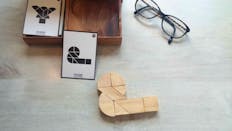Spatial Awareness Test (2026 Guide)
All products and services featured are independently selected by WikiJob. When you register or purchase through links on this page, we may earn a commission.
- A Free Example Spatial Reasoning Test
- What to Expect on a Spatial Ability Test in 2025
- Spatial Ability Question Types
empty
empty
empty
empty
empty
empty
empty
empty
empty
empty
- Practice Spatial Awareness Test 1
- How to Prepare for Spatial Ability Tests: Tips and Techniques for 2025
- How to Develop Your Spatial Reasoning Ability in 2026
- Practice Spatial Awareness Test 2
- Frequently Asked Questions
- Final Thoughts
Spatial awareness is required in production, technical and design jobs where plans and drawings are used; for example, engineering, architecture, surveying and design. It is also important in some branches of science where the ability to envisage the interactions of three-dimensional components is essential.
If you are applying for a job in the military, police or emergency services, you may be asked spatial reasoning questions. This will involve a map or street plan and you will need to show that you can understand directions and that you can use the map to plan, follow or describe routes.
Spatial ability tests bear a superficial resemblance to abstract reasoning tests, as both contain a series of pictorial figures rather than words or numbers. However, spatial ability does not involve analysis and reasoning: it is purely a test of mental manipulation.
Remember, you are not looking for the logical relationship between figures – what you are trying to do is form mental images, and visualize movement or change between them.
A Free Example Spatial Reasoning Test
To help you get an idea of what a spatial ability test involves, here is a mini test to get you started:
Credit: Psychometric Success
What to Expect on a Spatial Ability Test in 2025
Ability tests can take place at any stage in the recruitment process but are usually used to screen candidates before the first interview. Some organisations prefer to use them later on, say before a second interview or shortlisting, or at several times throughout the whole selection process.
These tests will normally be taken on a computer, either at your home, a test centre or assessment day. Questions will be multiple-choice and you will normally have a limited amount of time to answer, so you'll be expected to work quickly.
Spatial ability questions often involve:
- The visual assembly or disassembly of objects
- Objects that have been rotated or viewed from different angles
- Objects that have different markings on their surfaces
Generally speaking, if the questions involve the manipulation of two-dimensional objects then they are probably fairly straightforward, but you will be challenged to answer them all in the time you are given.
Questions involving the manipulation of three-dimensional objects are significantly more difficult. This is one skill that can be significantly improved with practice.
Your test score will usually be compared to a norm group. Each employer will have a certain standard that they will expect you to reach,so it pays to do the very best you can in the tests. This guide will help you prepare.
Prepare for Any Job Assessment Test with JobTestPrep
Spatial Ability Question Types
1. Shape Matching – Two Dimensional
In this example, you are asked to look at two groups of simple, flat objects and find pairs that are exactly the same size and shape.
Each group has 25 small drawings of these two-dimensional objects. The objects in the first group are labelled with numbers and are in numerical order. The objects in the second group are labelled with letters in alphabetical order.
Each drawing in the first group is exactly the same as a drawing in the second group. The objects in the second group have been moved and some have been rotated. You are not looking for reflections for these questions.
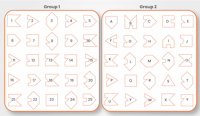
Which shape in Group 2 corresponds to a shape in Group 1?
This is very much a speed test, as you will be given far more of these questions than you can comfortably answer in the given time.
These questions use a large number of shapes that are presented close together. Some people find this very distracting and find it easier to work through the shapes in the second group systematically, rather than trying to look at the whole group at once.
In some questions of this type, there may not be a one-to-one match and some of the shapes in the first group may not appear in the second. The way that the question is worded will make this clear.
You should be especially careful to look out for reflections in the second group as these will be incorrect. These are often put in by the test designers to trap the unsuspecting.
For example:

The shapes in Group A are rotations of each other. The shapes in Group B are also rotations of each other. However, none of the shapes in Group A are rotations of those in Group B.
2. Visual Comparison – Two Dimensional
In these types of question, you will be presented with several objects, only two of which are identical. Once again, these are speed questions and you will need to work quickly and attempt to answer as many as possible in the given time.
Example Question

Which two pictures are identical?
Prepare for Any Job Assessment Test with JobTestPrep
The best strategy for these types of questions is to begin with the shape on the left and work through the shapes to the right of it, systematically looking for an exact match. If there isn’t one then move on to the second shape and repeat the process.
It can be quite difficult to discipline yourself to adopt this systematic approach, as you may think that it is quicker just to look at all of the shapes until the answer ‘jumps out’ at you. The problem with this is that if the answer doesn’t ‘jump out’ fairly quickly then panic sets in and you usually resort to the systematic approach anyway.
When you are confronted with a question like this that asks you to compare several different shapes, the other answer options can be distracting. It is much easier and less mentally tiring to cover the other shapes and concentrate only on the two shapes that you are comparing.
Prepare for Any Job Assessment Test with JobTestPrep
3. Group Rotation – Two Dimensional
This is slightly more complex than the rotations in the two-dimensional shape matching question.
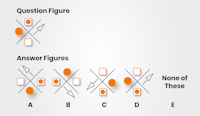
Which of the answer figures is a rotation of the question figure?
Once again, you need to be careful that you don’t identify reflections. The best strategy is to choose the most asymmetrical shape in the group – in this case, the arrow. Then determine how the shape would look going clockwise, anticlockwise and opposite.
In the example above, the white square is clockwise from the arrow. This means that A, B and D cannot be rotations of the question figure. This leaves only C as a possibility, which can quickly be checked element by element.
4. Combining Two–Dimensional Shapes
These questions show you a series of two-dimensional shapes. One of the shapes has been cut up into pieces. The questions present you with the pieces and you are asked to work out which of the shapes has been cut-up.
Example Question
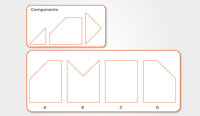
Which of the complete shapes can be made from the components shown?
The best strategy for answering these questions is to look at the complete shapes and see if there are any distinct features that would make it impossible to construct such a shape from the components. Sometimes there are one or two shapes that can be immediately discounted based on size alone.
One thing to remember is that if the complete shapes don’t have any bits sticking out (they usually don’t) then the components must fit together so that sides of the same length are together. This reduces the number of combinations considerably.
5. Cube Views in Three Dimensions
These questions show you several (usually three) views of a three-dimensional cube with unique symbols or markings on each face and then asks you a question about it. For example, which symbol is on the opposite face?
Example Question

Three views of the same cube are shown above. Which symbol is opposite the X?
If you need to prepare for a number of different employment tests and want to outsmart the competition, choose a Premium Membership from JobTestPrep.
You will get access to three PrepPacks of your choice, from a database that covers all the major test providers and employers and tailored profession packs.
Prepare for Any Job Assessment Test with JobTestPrep
Some people seem to have a natural talent for imagining objects in three dimensions and find these questions straightforward. However, if you’re not one of them and you find thinking in three dimensions difficult, there are other ways to get to the answer.
In the question above, for example, you can simply use a process of elimination. If you can see a symbol next to the ‘X’ on the cube, then it cannot be opposite.
The second and third cubes eliminate A, B and C. This leaves only D and ‘other’ as possibilities. D has edges shared with A and B, which would be consistent with the third cube illustrated. Therefore, D is correct.
Although it is not usually specified in the instructions, it is almost always true that in these questions each symbol is used only once. This means that even in cases where elimination is not possible, it is sometimes quite easy to see the solution without mentally manipulating the cube too much.
In the example above, you can simply compare the first and third illustrations. The third illustration shows a 90-degree anticlockwise rotation (looking at the cube from above) of the first illustration. Therefore, D must be opposite the ‘X’.
6. Cubes in Two and Three Dimensions
These questions show a flat (two-dimensional) pattern that can be folded to make a cube. The answer options will usually be four three-dimensional cubes.
The pattern and the cubes have symbols or markings on each face. You need to look at the pattern and decide which of the cubes, if any, could be made from it.
Example Question
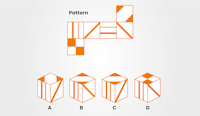
Which of the cubes shown could be made from the pattern?
The key to these questions is to remember that only three faces of the cube can be shown in the illustration, this means that you need only consider the relationship between the three visible elements on each cube and see if the same relationship exists in the pattern.
The best strategy for this type of question is to call one face of the cube the ‘front’ and then name the other faces of the cube in relation to it.
For example:

Obviously, this is an arbitrary decision as you could look at a cube from any side. However, thinking of the problem this way makes it much easier to see the relationship between the faces of the cube.
You can then:
- Look at the front of the cube
- Find that face on the pattern
- Use the pattern to identify the ‘top’ and eliminate any options that do not match
- Use the pattern to identify the other face that touches the ‘front’ (in this example LHS) and eliminate any options that do not match
The problem may also be posed the other way around. Here you would have a single three-dimensional cube and several two-dimensional patterns, only one of which, when folded, will make the cube.
7. Other Solids in Two and Three Dimensions
These questions are similar to the cube questions above but rather than cubes, they use other solid shapes which may be irregular.
In some respects, these questions are easier than the cube questions as there are more relationships to work with. In other words, each face of the solid shape has a shape of its own rather than just being square.
Example Question
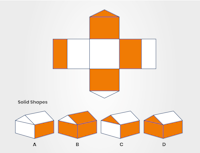
Which of the solid shapes shown could be made from the pattern?
Once again, you can reduce these problems to the relationship between the visible elements on the three-dimensional picture.
This makes things easier because even though the solid shape may have more faces than a cube, it is unusual for more than four faces to be shown.
This means that you need to consider the relationship between the four visible faces, paying particular attention to shading or other patterns on them.
Prepare for Any Job Assessment Test with JobTestPrep
8. Two-Dimensional Maps
Map questions will assess your ability to follow basic instructions and visualise a route. Normally, you will be given a two-dimensional plan or map and a series of directions via two or three questions that all relate to the same map.
You just need to use the instructions to navigate the map. As long as you have a basic sense of direction, this will seem relatively straightforward, but you will need to do so quickly and accurately.
Example Question
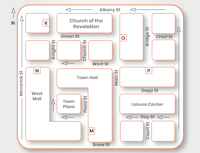
Officer Wilkinson is in Depp St and can see the Town Hall to her right. What direction is she facing?
A. North
B. South
C. East
D. West
She turns and walks to the junction with Main St. She turns left and proceeds two blocks before turning right, then taking the next right, and walking half a block. Which location is nearest to her current position?
A. M
B. N
C. R
D. P
The secret to getting the answers correct is imagining yourself walking down the street, making sure you are facing the correct way when deciding whether to turn left or right. You should also revise compass directions and make sure you are confident with each one, as well as the intermediate points such as north-west and south-east.
9. Block Counting in Three Dimensions
In these questions, you will be given a three-dimensional drawing of a shape formed from a group of blocks, some of which may be hidden.
You will be asked to identify how many blocks have been used to make up the shape. You will need to visualise the blocks you cannot see.
Example Question
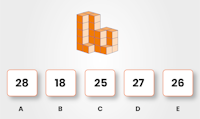
How many blocks make up the shape below?
10. Two-Dimensional Mirror Reflections
These questions will assess how you view two-dimensional objects from a different perspective. You will be presented with an image and will be asked to identify its mirror image.
Example Question

Which answer shows a reflection of the image below?
Credit: Psychometric Success
How to Prepare for Spatial Ability Tests: Tips and Techniques for 2025
These five spatial reasoning tips are well worth remembering before you take the spatial ability test for real:
- If you are allowed, bring and use a stopwatch. Calculate the maximum amount of time to be allocated to each question and stick to it.
- Research the different test providers so you know what to expect in your test.
- Work swiftly but carefully.
- Read the questions thoroughly and underline key words to keep you focused.
- Keep practising until you can answer all types of spatial ability question with ease.
How to Develop Your Spatial Reasoning Ability in 2026
Step 1. Take Practice Tests
As with many skills, practice will help you develop your spatial reasoning ability. To enhance your ability, you can take practice tests, like the ones within this article, which will help familiarise you with the types of questions involved.
Tests which also explain how to arrive at the answers are particularly good, such as the ones available from JobTestPrep here.
Step 2. Develop Your Skills
You can also develop your skills with practical day-to-day activities, such as looking at diagrams, plans and blueprints and imagining how they might fit together. Perhaps you could have a go at making or assembling something yourself using a set of plans.
Step 3. Draw Out Your Shapes
Drawing things in 3D can also be helpful, as you will start to understand how different shapes look from different perspectives. Similarly, you can draw a shape, have a go at creating its reflection and then check whether you are right using a mirror.
Prepare for Any Job Assessment Test with JobTestPrep
Credit: Psychometric Success
Frequently Asked Questions
A spatial awareness test is an aptitude assessment that is used by many employers as part of the hiring process. It is often compared to an abstract reasoning test because it involves the use of images instead of numbers and words.
However, spatial awareness tests assess mental manipulation, rather than analysis and reasoning skills.
Spatial awareness tests are common in the recruitment process for roles in the emergency services and military. Candidates applying for jobs in design, production, and technical professions may be required to sit a spatial awareness.
Since most tests are online, you will need to manipulate images in your mind, rather than by using a piece of paper.
To pass a spatial awareness test, you will need to correctly solve problems relating to objects. This includes the visual assembly or disassembly of objects, objects that have been rotated or are being examined from different angles, and objects with different surface markings.
Problems relating to 2D objects tend to be easier to solve than problems relating to 3D objects.
For the best chance of passing, read the instructions carefully, improve your time management, and practice your spatial reasoning abilities. Not all spatial awareness tests are the same, so you will need to research the publisher to find out what to expect from the test.
Spatial reasoning tests measure and assess spatial reasoning ability and fluid intelligence. A candidate's performance gives the employer an idea of their ability to work with 2D and 3D objects. It also shows whether they can find patterns between shapes, and mentally manipulate objects.
Spatial awareness comes naturally to some people. Others benefit from spending time developing their spatial awareness skills. Poor spatial awareness can be caused by developmental disorders.
These include Asperger’s Syndrome, attention deficit disorder (ADD), attention deficit hyperactivity disorder (ADHD), cerebral palsy, dyspraxia or autism.
Spatial awareness tests are available from a variety of publishers. Each spatial awareness test is different, and this includes the assessment duration. The Psychometric Success Spatial Ability Practice Test (1) comprises 45 questions.
In this test, candidates have 20 minutes to answer as many questions as possible. Speak to your prospective employer to find out how long the spatial awareness test they use is.
To prepare for spatial reasoning tests, you should complete a range of practice assessments. This will help to improve your time management. It will also help you to familiarise yourself with the type of problems you will need to solve.
Find out which test provider is being used by your prospective employer so that you can find out what to expect from that specific test. Practice reading the questions thoroughly, underlining important words to ensure you stay focussed.
Practice answering questions from all areas of the test. Spend more time on the questions that you find most difficult. Keep practicing until you can answer all types of spatial reasoning questions with confidence. Use your imagination to think about how everyday objects might fit together.
You could also try drawing objects in 3D. Think about how shapes appear from different perspectives. Try drawing a shape, illustrating its reflection, and using a mirror to check if you are correct.
Spatial IQ scores are usually compared within a norm group. This means that your performance will be assessed against other people taking the same test. Most employers set a benchmark to decide which test-takers will progress to the next part of the hiring process.
Spatial reasoning tests are designed to evaluate an individual's ability to mentally manipulate and understand spatial relationships.
These tests are often used to assess aptitude in fields such as mathematics, engineering, architecture, and the sciences.
Here are some common types of spatial reasoning tests:
- Pattern Completion
- Paper Folding
- Spatial Visualization
- Figure Classification
- Mental Cutting and Assembly
- Spatial Analogies
- Hidden Figures
- Perspective Taking
Final Thoughts
Spatial ability is an important skill in many industries and one which employers value highly.
Some people find it easy to visualise both two and three-dimensional images and diagrams, but even if it doesn't come naturally, thorough practice of all the different question types and a process of elimination will greatly improve your chances of success.



